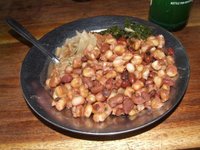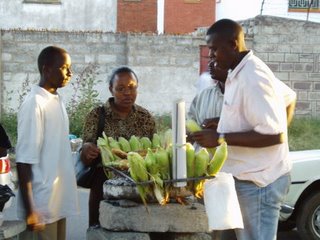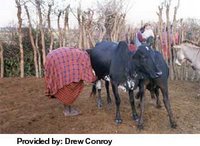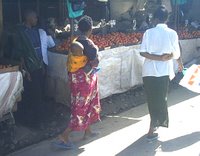:::::::::::::::::::::::::::::::::::::::::::::::::::::::::::::::::::::::::::::::::::::::::::::::::::::
Mango
***** Location: Tropics
***** Season: Hot and dry in Kenya
........ others see below
***** Category: Plant
*****************************
Explanation
There are mangoes in Kenya at any time of year -- but it is in the hot and dry season when many different varieties come on the market at the same time.
The Apple and Tommy mangoes -- round and sweet, hardly any strings, lots of juice -- are some of the best on the market in this season, while the Ngowe mango (longer, yellow-skinned) is available year round, from various parts of Kenya and its East African neighbours.
Isabelle Prondzynski
:::::::::::::::::::::::::::::::::::::::::::::::::::::::::::::::::::::::::::::::::::::::::::::::::::::
Tommy Atkins (after whom the Tommy mango is named)
He's in his early 80s and is an international wooer of adoring women. Actually this variety of mango was developed in Florida, USA in the 1920s. It was meant for commercial export, and today, along with Keith (another variety) dominates international trade. To make sure you are not too taken by this rogue, I must tell you he is not on the list of the 20 top-tasting mangoes.
Ed Schwellenbach
:::::::::::::::::::::::::::::::::::::::::::::::::::::::::::::::::::::::::::::::::::::::::::::::::::::
Mango Fruit Facts : Mangifera indica L.

Common Names: Mango, Mangot, Manga, Mangou.
Related species: Bindjai (Mangifera caesia), Horse Mango (M. foetida), Kuweni mango (M. odorata).
Origin:
The mango is native to southern Asia, especially Burma and eastern India. It spread early on to Malaya, eastern Asia and eastern Africa. Mangos were introduced to California (Santa Barbara) in 1880.
Forms:
The mango exists in two races, one from India and the other from the Philippines and Southeast Asia. The Indian race is intolerant of humidity, has flushes of bright red new growth that are subject to mildew, and bears monoembryonic fruit of high color and regular form. The Philippine race tolerates excess moisture, has pale green or red new growth and resists mildew. Its polyembryonic fruit is pale green and elongated kidney-shaped. Philippines types from Mexico have proven to be the hardiest mangos in California.
Read a lot more here:
http://www.crfg.org/pubs/ff/mango.html
:::::::::::::::::::::::::::::::::::::::::::::::::::::::::::::::::::::::::::::::::::::::::::::::::::::
http://freshmangos.com/mangos.html,
a great link to our subject.
The mango is known as the 'king of fruit' throughout the world.
The mango is a member of the Anachardiaceae family. Other distant relatives include the cashew, pistachio, Jamaica plum, poison ivy and poison oak.
All About Mangos More mangos are eaten fresh all over the world than any other fruit!
Varieties of Mangos
Facts & Myths : The Mango tree plays a sacred role in India; it is a symbol of love and some believe that the Mango tree can grant wishes. And much more
The World's Largest On-line Mango Recipe Guide! : "MangoPickle in Brine" might go really well with a Japanese meal.
Ed Schwellenbach
:::::::::::::::::::::::::::::::::::::::::::::::::::::::::::::::::::::::::::::::::::::::::::::::::::::
Plant characteristics :
The mango tree is an evergreen perennial. Its height, when mature, depends on the variety; some of the smaller fruited varieties grow to a height of 60 ft (c. 18 m) or more, whilst other varieties grow to only half this height. The foliage is produced in flushes; at first, it is yellow, pale green or red, but it becomes dark when mature. One part of a tree may be producing young flush growth whilst the rest of the foliage is mature. The inflorescences are also produced in flushes; these occur at different times of the year in different parts of East Africa, but the generally occur after the main periods of vegetative growth.
Each inflorescence consists of as many as 6,000 flowers, most of which are male, the remainder being hermaphrodite. The hermaphrodite flowers are insect pollinated, but as few as 0.1 % set fruit. Each inflorescence produces very few fruit; in the larger fruited varieties only one is usually produced but in varieties with smaller fruits there may be three to five.
The fruit consists of the following : the skin, or exocarp, whose colour may be green, yellow, red or purple according to the variety, the edible flesh, or mesocarp; the woody husk, or endocarp, which usually has fibres extending into the flesh, and the seed, which is embedded in the husk. The period from flowering to fruit maturity is about five months.
Most of the East African mango varieties exhibit polyembryony, i.e. each seed produces, in addition to the sexual seedling, one to five nucellar seedlings which are genetically identical to the parent plant. Monoembryonic varieties produce only one embryo per seed; as this embryo is of sexual origin such varieties do not breed true to type. Uniformity can only be achieved in monoembryonic varieties by vegetative propagation.
Ecology :
Mangoes grow well in areas which receive poor and erratic rainfall, e.g. the central part of Tanzania, where an average annual rainfall of only 25 in (c. 650 mm) is common. They grow best at a higher rainfall than this but a dry period is essential at flowering and fruiting; rain at flowering can cause a high incidence of fungal infections on the inflorescences. Mangoes are limited to the lower altitude areas and are seldom seen above 5,000 ft (c. 1,500 m).
Two Kenya selections, Sabre and the Harries mango, can be grown as high as 6,000 ft (c. 1,800 m).
Mangoes do not require soils with a high nutrient content but the must be free draining and deep.
Pests :
The most important pest is the mango weevil, Sternocochetus mangiferae. The larvae enter the fruit, leaving no external sign of their entry, and attack the seeds. There is often a hard white area in the flesh of mangoes which may be caused by the entry of mango weevil larvae.
J D Acland, East African Crops, FAO 1971
Plant of the Month : Mango
You can take unripe mangoes and place them in a brown paper bag, add an apple if you have, and keep them outside at room temperature. The mango will ripen within a few days, check it regularly. These home-ripened mango are quite delicious.
artificially ripened mangoes
Home-grown mango come from your own orchard.
:::::::::::::::::::::::::::::::::::::::::::::::::::::::::::::::::::::::::::::::::::::::::::::::::::::
MANGO TALES (of India)
by Isidore Domnick Mendis
Though mango plays a very important role on the Indian dining table it has many other usages. Romance of the Mango, written by Kusum Budhwar and published by Penguin Books touches on all aspects of the king of fruits, especially its reference in mythology, poetry, sculptures, paintings and textiles.
In the 15th century one of the Portuguese Governor Generals took the Alphonso variety grown in Goa to Brazil which was also governed by Portugal. In return he brought the cashew, a native of Brazil. Both mango and cashew adapted themselves to their new homes," says Budhwar.
Today Brazil has over 600 varieties but many popular ones like Espada, Bourbom, Carlota and Augusta are variants of the Indian Alphonso. Similarly the American varieties like Haden and Kent grown in Florida too are Alphonso variants.
One of the most fascinating aspects of the book is the reference of mangos in religion. "Lord Shiva married Parvati under a mango tree. Lord Ganesha's love for mangoes and ladoos is legendary. Lord Hanuman consumed the mangoes that Ravana sent for Sita who was in his captivity. The fruit finds mention several times in Ramayana, Mahabharata and the Puranas," says the author. Even the Buddhists, Jains and Parsis consider the mango tree holy. Some Christians even use it as a Christmas tree, says Budhwar.
The fruit is inextricably linked to Indian art. Mango motifs can be seen in paisley shawls of Kashmir, they are also on gota and kinari work and can be found on many traditional Indian sarees. In many parts of India the mango motif is a must in the bridal trousseau. The Balucheri saris of Bengal and Kanchivaram saris of Tamilnadu have mango motifs woven into them.
There is a lot more on this link:
http://www.the-south-asian.com/May-June2003/mango_tales.htm
*****************************
Worldwide use
Brazil
The mango is a very popular fruit in Amazonia, even though it comes from Asia.
In Amazonas, the mango tree, begins to bloom in July, in the beginning of the dry season. Its fruit production begins in September, with the largest harvest occurring from October to January, rarely until March (rainy season).
The tree can be found in many backyards of local homes. Not long ago the mango tree had great importance as an ornamental along the avenues of Manaus, softening the hardness of the cement constructions. Unfortunately, local politics caused great impact by substituting for more cement those green areas, leaving in the residents' memory only the history of the avenues adorned with such beautiful trees. Fortunately, the same didn't happen in the city of Belém, which still maintains mango trees in their streets and explains one of the names: "city of the mango trees". Since the same did not occur in Manaus, the mango trees are part of childhood memories, yielding a lot of histories to tell.
Amazonia produces several types of mango fruit, with forms, colors, flavors and sizes particular to each one. Some types are more popular than others, with the manguita, the pink mango and the common mango the ones that fall in the preference of most of the Amazonian people. The manguita got its name because it´s a small fruit, weighing about 65-90g with the seed weighing 8-10g, and a pulp with a sweet mild flavor. The common mango is just a little larger, but its flavor is not as attractive as that of the manguita, although it is also pleasant. The tree of the common mango was the common along the city's avenues.
The pink mango is very coveted. It stands out in the tree for its size (450-550g and seed 35-50g) and strong pink color. Its flavor and smell are also very appreciated. It´s difficult to pass by a mango tree full of fruits and resist the desire of having one in hand. This is because from the height of their portliness they awaken the impulse of wanting to reach them, sometimes even without their owners' permission.
Some people prefer to eat the mango still green, seasoning it with salt. There are those that prefer it ripe or almost ripe, cut with a knife or peeled with the teeth or sucked until the fibers become clean and stretched, even if they get stuck in the teeth. Formerly, when the children sucked the mango to that point, they used the seed to play with. It was common to make a horse by nailing pieces of thick wire to give it legs and a tail, and to use a bottle cap or cork for a head. It depended on the artisan to select the appearance of the animal. The mango tree was also the most common tree for childhood climbing and the one that best allowed arrival at the top due to the abundance of strong branches. Thanks to it, many boys inflated their chests with pride for having gotten to observe the neighborhood from the highest point.
Besides these traditional uses, that were maintained for a long time, now the fruit of the mango is used in several forms in Amazonian cuisine. Nowadays, the pulp has regular presence in the local supermarkets. It can be found in processed forms, wrapped in bags with varied amounts for the preparation of juices, in the form of ice creams, creams, and other sweet and salty recipes, showing its versatility in times of global changes. In any form that it comes, it is always a delicacy.

parking lot
waiting with birds for mangoes
to ripen in the trees
nothing moves--
the mangoes in the tree
turning yellow
Rosa Clement, May 2008
BRAZIL SAIJIKI
:::::::::::::::::::::::::::::::::::::::::::::::::::::::::::::::::::::::::::::::::::::::::::::::::::
India
mangoes-
planter waits to ripen
also a squirrel
In fact in the villages, kids prefer to eat the semi-ripe mangoes half-eaten by Squirrels - it is believed that the squirrels know which one to bite into and they run away when there is noise around leaving the half-eaten ones.
By the way, following the principle of TRINITY, the fruit-trinity, as per the Tamilian lore, consists of Banana (Plantain), Mango, and Jack Fruit . We can find quite a lot of references to "mukkani" (the Tamil word meaning "3-fruits") in Tamil literature and folk lore.
A. Thiagarajan
hanging mangoes
kigo for mid-may
.................................................................................
home-ripened mangoes
I hear my grandmother's voice
in my mother's
Kala Ramesh
source : The Mainichi, Japan, June 2012
:::::::::::::::::::::::::::::::::::::::::::::::::::::::::::::::::::::::::::::::::::::::::::::::::::::
Philippines
 The mango is the national fruit of The Philippines. Whoever decided this made a good decision.
The mango is the national fruit of The Philippines. Whoever decided this made a good decision.Our variety has a rich golden colour, and is finger-licking yummy. It's one of the things that influence my decision to visit. We once went to the open market and bought two kilos and a knife, then returned to our hotel room and ate all of it for the next couple of hours.
How to eat a mango:
1 You could slice off both cheeks and scoop the fruit out with a spoon, then pierce the large seed with a knife, peel the skin off, and bite off the remaining flesh.
2 You could also slice the flesh into small pieces, put it all in a blender with crushed ice (for health and safety reasons, use bottled water to make the ice!!!), and voila! ... mango shake!
3 Green mango slices are also a favourite. This is unripe mango, which is very sour. You dip the slices in salt or 'bagoong', which is anchovy paste. Usually eaten as an afternoon snack; often sold on the sidewalk, complete with dip.
4 Dried mango - just open the bag and munch as much as you like! It's candy and fruit in one.
By the way, the tastiest mangoes are those which are grown without artificial fertilizers. Too many chemicals affect the taste of the fruit. These days we call it biological farming; not such a new concept after all.
Ella Wagemakers
Philippines mango More reference.
:::::::::::::::::::::::::::::::::::::::::::::::::::::::::::::::::::::::::::::::::::::::::::::::::::::
Yemen
kigo for summer
mango harvest -
the sun peels
a man's face
Heike Gewi, Yemen, Summer 2008
Mangos were introduced to Yemen in the 20th century.
READ
Mangos find a place in Yemen
*****************************
Things found on the way
.. .. .. .. .. Botswana Haiku
Students were asked to do a piece of creative writing using the characteristics (whether formal or not) of one of the texts that we discussed during the semester. The assignment required that they follow the conventions and characteristics of the text (China, Japan, Puerto Rico, and ancient Mesopotamia) but used their own experiences in Botswana for the content.
http://www.thuto.org/english/courses/eng434/botshaiku.htm
xxxxxxxxxxxxxxxxxxxxxxxxxxxxx
The Mango Worm or Mango Fly
http://www.bbcgf.org/far/oct2003/goodthings.html
http://www.amershamhealth.com/medcyclopaedia/medical/volume%20III%201/AFRICAN%20EYE%20WORM%20DISEASE.ASP
:::::::::::::::::::::::::::::::::::::::::::::::::::::::::::::::::::::::::::::::::::::::::::::::::::
In India, mango trees can be decorated as Christmas trees :
Let us take a look at what are the various way of celebrating Christmas in India. Generally the Christians who live in the plains decorate mango or banana trees at Christmas time. Some of them also decorate their houses with mango leaves. However in some of the other parts of India, a lot of people use small clay oil-burning lamps as Christmas decorations. These small clay lamps are placed on the edges of flat roofs and on the tops of walls.
http://www.indianchild.com/christmas/christmas_in_india.htm
Christmas celebrations vary in different parts of India. In some parts, small clay oil-burning lamps, mango leaves etc are used as Christmas decorations and mango and banana trees are decorated. All the major Indian cities wear a festive look. Shops and bazaars are decorated for the occasion and offer attractive bargains.
http://www.webindia123.com/festival/dec/christmas.htm
*****************************
HAIKU
slurping
plump sweet Tommy mangoes --
bring me Tommy!
raising its head
into sudden daylight --
surprised mango larva.
Going home on the bus this evening, one of the lower-income areas had stands selling piles of small green mangoes, which reminded me of a famine period not long ago :
drought and famine
nothing to eat but
small green mangoes
These mangoes are sweet and juicy, but have more than their fair share of strings. I have yet to hear their specific name in Kikuyu or Swahili -- they are simply called mangoes in both (iembe / embe) and were probably the only variety of mango that grew up-country until the last century.
Isabelle Prondzynski
xxxxxxxxxxxxxxxxxxxxxxxxxxxxx
A hot long harsh day
I crept into the shadow
Of a mango tree
S. I. Nkatogang
http://www.thuto.org/english/courses/eng434/botshaiku.htm
xxxxxxxxxxxxxxxxxxxxxxxxxxxxx
Kona wind
sticky even before
this mango
the 'kona wind' is the wind that hits the northern shore of the big island of hawaii. kona is an area on that coast. coffee and chocolate grow there. there are also many cattle ranches there. the kona wind is rather hot, and you feel uncomfortable and sticky because of it.
susan delphine delaney
(won a first prize in the hawaii education association contest one year)
About Kona in Hawaii.
http://www.konaweb.com/
http://www.konaweb.com/konaweb/index.shtml
xxxxxxxxxxxxxxxxxxxxxxxxxxxxxx
the monk bows
for the mango tree
leaves in flushes
a fond embrace
the taste of mango
on her lips
Geert Verbeke
Read more of Geert's Mango Haiku here:
http://happyhaiku.blogspot.com/2004/01/friends-geert-verbeke.html
:::::::::::::::::::::::::::::::::::::::::::::::::::::::::::::::::::::::::::::::::::::::::::::::::::::
Mango Haiku
Ester Obwamu, Kenya
**********************************
Related words
***** Mango Blossoms
kigo for spring in India
Mango Blossoms – early March - the phrase encapsulates and symbolizes the essence of spring.
Mangoes are so widely grown in India – and the blossoms are simply too beautiful to look at. Mango trees would be covered with buds and blossoms so fine that we would hardly be able to see the young leaves or the branches!
In madras – most houses have mango trees and the city out-skirts have mango groves- vast acres of it.
And when on a visit to these mango groves in early March, you would see the trees covered in a soft brownish canopy of buds and blossoms – millions of them . . . .
the coming of spring so visible . .
childhood home. . .
gentle breeze caresses
the mango blossoms
Kala Ramesh, India
:::::::::::::::::::::::::::::::::::::::::::::::::::::::::::::::::::::::::::::::::::::::::::::::::::::
first bloom
in my mango tree
a vacant nest
Dr.Vidur Jyoti, India, March 2008
:::::::::::::::::::::::::::::::::::::::::::::::::::::::::::::::::::::::::::::::::::::::::::::::::::::
his sunburned face
on my pillow -
mango blossoms
Gabi Greve, travelling in India 1979
xxxxxxxxxxxxxxxxxxxxxxxxxxxxx
Two Tahitian Women with Mango Blossoms
Paul Gauguin.

1899. Oil on canvas. The Metropolitan Museum of Art
http://www.abcgallery.com/G/gauguin/gauguin71.html
xxxxxxxxxxxxxxxxxxxxxxxxxxxxx
How to make a dish called Mango Blossoms out of a mango:
Slide a sharp knife parallel to broad side of mango and against pit; cut off both sides.
Place halves cut side up; cut flesh to the skin, but not through, to make 1/2" squares.
Gently push up the skin to flare out mango sections; serve with orange wedges.
http://search.yumyum.com/recipe.htm?ID=4970
:::::::::::::::::::::::::::::::::::::::::::::::::::::::::::::::::::::::::::::::::::::::::::::::::::::
***** Mango Blossom Honey
non-seasonal topic
Looking for a photo of a mango blossom, I found this:
Mango Blossom Honey: A dark amber honey, Mango Blossom reveals smoke, butter, black cherries and high notes of passion fruit to provide a truly sensual experience.
Made in Java
http://www.igourmet.com/shoppe/shoppe.asp?cat=2
:::::::::::::::::::::::::::::::::::::::::::::::::::::::::::::::::::::::::::::::::::::::::::::::::::
noonday sun --
a child squeezes her mango
to the last droplet
James Bundi
2011
:::::::::::::::::::::::::::::::::::::::::::::::::::::::::::::::::::::::::::::::::::::::::::::::::::::
a mango leaf
the entire world
of the unnamed bug
Suhit Kelkar
Maharashtra, India
The Heron's Nest - September 2012
:::::::::::::::::::::::::::::::::::::::::::::::::::::::::::::::::::::::::::::::::::::::::::::::::::::
[ . BACK to WORLDKIGO . TOP . ]
:::::::::::::::::::::::::::::::::::::::::::::::::::::::::::::::::::::::::::::::::::::::::::::::::::::


















